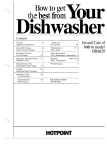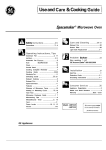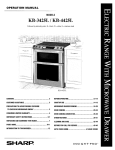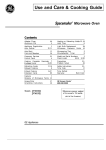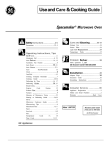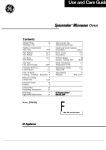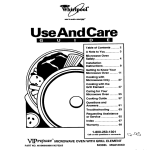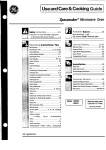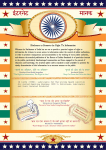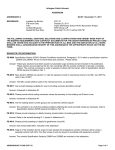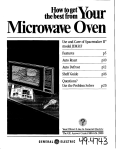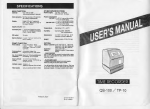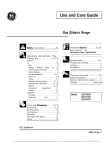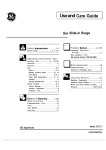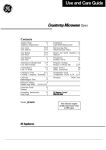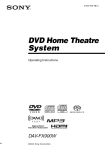Download GE JE1468K User's Manual
Transcript
Countertop Microwave Oven
Contents
Adapter Plugs
Add :30 Seconds
:12
10
H(Jld Time
Installation
8
32
:3:3
3
Appliance Registrati(m
Auto C:ook
2
19,20
Light Bulb Replacement
Microwaving Tips
Aut{} Defrost
Auto Reheat
14, 15
17, 18
Minute/Second Timer
Model and Serial Numbers
Auto Roast
Auto Simmer
12, 1:+
1:;
Popcorn”
P{}wer Levels
Auto Start
16
Automatic Cooking [;uide 5, 19-20
8
2,6
11
8-1:3, 16
Precauti(ms
Problem Solver
2-5
34
{:are and Cleaning
(;(msumer Services
3:3
:35
Program {;ooking
Recipes, C(~oking Tips
CJontrol Panel
(:ookingby Time
7
10
Safety Instructions
Temperature (:(~(~k
{looking” (;ornplete Reminder
{:ookware
2!
Ternpemture Probe 4,6,12,113,16, :33
Warranty
Back ~;over
Defrostingby Time
Delayed C;(~oking
5
22-29
2-5
16
9
8
Double Duty Shelf 4,5,6, :+(), 131, ~3~3
Extension ~:{~rds
:32
Features
CJrounding Instructions
ModelJE1468K
6
:32
GE Answer Centera
800.626.2000
Microwave power output
of this oven is 800 watts.
IEC-705 l’est Procedure
GE Appliances
Help us help you...
Before using your oven,
read this book carefully.
It is intended to help you operate
and maintain your new microwave
oven properly.
Keep it handy for answers to your
questions.
If you don’t understand something
or need more help, write (inciude
your phone number):
Consumer Affairs
GE Appliances
Appliance Park
Louisville, KY 40225
Write down the model and
serial numbers.
You’ll find them on a label inside
the oven.
These numbers are also on the
Consumer Product Ownership
Registration Card that came with
your microwave oven. Before
sending in this card, please write
these numbers here:
This appliance must be registered.
Please be certain that it is.
Write to:
GE Appliances
Range Product Service
Appliance Park
Louisville, KY 40225
If you received a
damaged oven...
Immediately contact the dealer (or
builder) that sold you the oven.
Save time and money.
Before you request service...
Check the Problem Solver in the
back of this book. It lists causes of
minor operating problems that you
can correct yourself.
All these things are normal
with your microwave oven.
Steam or vapor escaping from
around the door.
Light reflection around door or
outer case.
Dimming oven light and change
in blower sound may occur while
operating at power levels other
than high.
Dull thumping sound while oven
is operating.
Some TV-Radio interference
might be noticed while using your
microwave oven. It’s similar to the
interference caused by other small
appliances and does not indicate a
problem with your oven.
●
●
Model Number
●
Serial Number
Use these numbers in any
correspondence or service calls
concerning your microwave oven.
Be sure your microwave
oven is registered.
It is important that we know the
location of your microwave oven
should a need occur for
adjustments.
Your supplier is responsible for
registering you as the owner.
Please check with your supplier to
be sure he has done so; also send
in your Consumer Product
Ownership Registration Card. If
you move, or if you are not the
original purchaser, please write to
us, stating model and serial
numbers.
2
●
NEXT, if yOLI are still not pleased,
write all the details—including
your phone number-to:
Manager, Consumer Relations
GE Appliances
Appliance Park
Louisville, KY 40225
FINALLY, if your problem is still
not resolved, write:
Major Appliance Consumer
Action Panel
20 North Wacker Drive
Chicago, IL 60606”
PRECAUTIONS
TO AVOID
POSSIBLE
EXPOSURE TO
EXCESSIVE
MICROWAVE
ENERGY
(a) Do Not Attempt to operate this
oven with the door open since
open-door operation can result in
harmful exposure to microwave
energy. It is important not to defeat
or tamper with the safety
interlocks.
●
If you need service...
To obtain service, see the
Consumer Services page in the
back of this book.
We’re proud of our service and
want you to be pleased, If for some
reason you are not happy with the
service you receive, here are three
steps to follow for further help.
FIRST, contact the people who
serviced your appliance, Explain
why you are not pleased. In most
cases, this will solve the problem.
(b) Do Not Place any object
between the oven front face and
the door or allow soil or cleaner
residue to accumulate on sealing
surfaces.
(c) Do Not Operate the oven if it
is damaged. It is particularly
important that the oven door close
properly and that there is no
damage to the:
(1) door (bent)
(2) hinges and latches (broken or
loosened)
(3) door seals and sealing surfaces.
(d) The Oven Should Not be
adjusted or repaired by anyone
except properly qualified service
personnel.
IMPORTANT SAFETY
INSTRUCTIONS
Read all instructions before using this appliance.
Microwaving Tips
●
Make sure all cookware used in
your microwave oven is suitable
for microwaving. Most glass
casseroles, cooking dishes,
measuring cups, custard cups,
pottery or chinu dinnerware which
does not have metallic trim or
glaze with a metal I ic sheen can be
used. Some cookware is labeled
“suitable for microwaving.’>
When using electrical
appliances, basic safety
precautions should be followed,
including the following:
WARNING–TO
reduce
the risk of burns, electric
shock, fire, injury to persons
or exposure to excessive
microwave energy:
Use this appliance only for
its intended use as described
in this manual. Do not use
corrosive chemicals or vapors
in this appliance. This
microwave oven is specifically
designed to heat or cook food,
and is not intended for laboratory
or industrial use.
●
Read and follow the specific
“PRECAUTIONS TO AVOID
POSSIBLE EXPOSURE TO
EXCESSIVE MICROWAVE
ENERGY” on page 2.
●
If you are not sure if a dish is
microwave-safe, use this test:
Place in the oven both the dish you
are testing and a glass measuring
cup filled with one cup water—set
the measuring cLlp either in or next
to the dish. Microwave 1 minute at
high. It the dish heats, it should not
be used for microwaving. If the
dish remains cool and only the
water in the cup heats, then the
dish is microwave-safe.
Paper towels, waxed paper and
plastic wrap can be used to cover
dishes in order to retain moisture
and prevent spattering. Be sure to
vent plastic wrap so steam can
escape.
●
Some microwaved foods
require stirring, rotating or
rearranging. Check cookbook
supplied.
●
Steam builds up pressure in
foods which are tightly covered
by a skin or membrane. Pierce
potatoes, egg yolks and chicken
livers to prevent bursting.
●
“ This appliance must be
grounded. Connect only to
properly grounded outlet.
See “GROUNDING
INSTRUCTIONS” on page 32.
For best operation, plug
this appliance into its own
electrical outlet, to prevent
flickering of lights, blowing of
fuse or tripping of circuit breaker.
●
Install or locate this
appliance only in accordance
with the provided Installation
Instructions.
●
Be certain to place the front
surface of the door three
inches or more back from the
countertop edge to avoid
accidental tipping of the
appliance in normal usage.
●
Do not cover or block any
openings on the appliance.
Do not store this appliance
outdoors. Do not use this
product near water-for
example, in a wet basement,
or near a swimming pool.
●
Do not immerse power cord
or plug in water.
●
Keep power cord away from
heated surfaces.
Do not let power cord hang
over edge of table or counter.
●
●
Do not operate this
appliance if it has a damaged
power cord or plug, if it is not
working properly, or if it has
been damaged or dropped.
●
c See door surface cleaning
instructions in the Care and
Cleaning section(s) of this
book.
This appliance should be
serviced only by qualified
service personnel. Contact
nearest authorized service
facility for examination, repair
or adjustment.
●
As with any appliance, close
supervision is necessary when
used by children.
●
To reduce the risk of fire in
the oven cavity:
—Do not use the oven for
storage purposes. Do not leave
paper products, cooking utensils,
or food in the oven cavity when
not in use.
—Do not overcook food.
Carefully attend appliance
if paper, plastic or other
combustible materials are
placed inside the oven to
facilitate cooking.
●
((<)llti}fl~c,[l tle.xt l?~lgc,)
●
3
IMPORTANT SAFETY INSTRUCTIONS (continued)
—Remove wire twist-ties from
paper or plastic bags before
placing bags in oven.
—Do not use your microwave
oven to dry newspapers.
—Do not use recycled paper
products. Recycled paper
towels, napkins and waxed
paper can contain metal flecks
which may cause arcing or
ignite. Paper products
containing nylon or nylon
filaments should be avoided,
as they may also ignite.
—Do not pop popcorn in your
microwave oven unless in a
special microwave popcorn
accessory or unless you use
popcorn labeled for use in
microwave ovens.
—Do not operate the oven
while empty to avoid damage
to the oven and the danger of
fire. If by accident the oven
should run empty a minute or
two, no harm is done. However,
try to avoid operating the oven
empty at all times—it saves
energy and prolongs the life of
the oven.
—Do not overcook potatoes.
They could dehydrate and
catch fire, causing damage to
your oven.
If materials inside oven
should ignite, keep oven door
closed, turn oven off, and
disconnect power cord, or shut
off power at the fuse or circuit
breaker panel.
●
Some products such as
whole eggs and sealed
containers—for example,
closed jars—will explode and
should not be heated in this
microwave oven. Such use of
the microwave oven could
result in injury.
●
Avoid heating baby food in
glass jars, even without their
lids; especially meat and egg
mixtures.
●
Don’t defrost frozen
beverages in narrow necked
bottles (especially carbonated
beverages). Even if the
container is opened, pressure
can build up. This can cause the
container to burst, possibly
resulting in injury.
●
Use metal only as directed in
this book and the cookbook
provided with your microwave
oven. TV dinners may be
microwaved in foil trays less
than 3/4” high; remove top foil
cover and return tray to box.
When using metal in the
microwave oven, keep metal
(other than metal shelo at
least 1 inch away from sides
of oven.
●
c Cookware may become hot
because of heat transferred from
the heated food. Pot holders
may be needed to handle the
cookware.
Sometimes, the glass cooking
tray can become too hot to
touch. Be careful when
touching the tray during and
after cooking.
●
Foods cooked in liquids
(such as pasta) may tend to boil
over more rapidly than foods
containing less moisture.
Should this occur, refer to the
Care and Cleaning section for
instructions on how to clean the
inside of the oven.
●
Thermometer—Do not use a
thermometer in food you are
microwaving unless the
thermometer is designed or
recommended for use in the
microwave oven.
●
c Remove the temperature
probe from the oven when not
using it to cook with. If you
leave the probe inside the oven
without inserting it in food or
liquid, and turn on microwave
energy, it can create electrical
arcing in the oven and damage
oven walls.
Plastic cookware—Plastic
cookware designed for
microwave cooking is very
useful, but should be used
carefully. Even microwave-safe
plastic may not be as tolerant of
overcooking conditions as are
glass or ceramic materials and
may soften or char if subjected to
short periods of overcooking. In
longer exposures to overcooking,
the food and cookware could
ignite. For these reasons: 1 ) Use
microwave-safe plastics only and
use them in strict compliance
with the cookware manufacturer’s
recommendations. 2) Do not
subject empty cookware to
microwaving. 3) Do not permit
children to use plastic cookware
without complete supervision.
●
When cooking pork, follow
the directions exactly and
always cook the meat to an
internal temperature of at least
170°F. This assures that, in the
remote possibility that trichina
may be present in the meat, it
will be killed and meat will be
safe to eat.
●
Do not boil eggs in a
microwave oven. Pressure will
build up inside egg yolk and
will cause it to burst, possibly
resulting in injury.
●
Foods with unbroken outer
“skin” such as potatoes,
sausages, tomatoes, apples,
chicken livers and other giblets,
and egg yolks (see previous
caution) should be pierced to
allow steam to escape during
cooking.
●
Not all plastic wrap is
suitable for use in microwave
ovens. Check the package for
proper use.
●
Spontaneous boiling—Under
certain special circumstances,
liquids may start to boil during
or shortly after removal from
the microwave oven. To prevent
burns from splashing liquid, stir
the liquid briefly before
removing the container from the
microwave oven.
~~Boilable’? cooking pouches
and tightly closed plastic bags
should be slit, pierced or vented
as directed by package. If they
are not, plastic could burst
during or immediately after
cooking, possibly resulting in
injury. ‘Also, plastic storag-e
containers should be at least
partially uncovered because
they form a tight seal. When
cooking with containers tight Y
covered with plastic wrap,
remove cover;ng carefully and
direct steam away from hands
and face.
●
Use of the DOUBLE DUTYTM
Shelf accessory.
—Remove the shelf from oven
when not in use.
—Do not store or cook with shelf
on floor of oven. Product damage
may result.
—Use pot holders when handling
the shelf and cookware. They may
be hot.
—Do not use microwave browning
dish on shelf. The shelf could
overheat.
—Be sure that the shelf is
positioned properly inside the
oven to prevent product damage.
Use of shelf with Auto Cook,
Auto Reheat or Popcorn feature
is not recommended (see the Auto
Cook, Auto Reheat, or Popcorn
sections).
Program Cooking
SAVE THESE
INSTRUCTIONS
When You Plug in
the Oven
●
●
Hot foods and steam can
cause burns. Be careful when
opening any containers of hot
food, including popcorn bags,
cooking pouches and boxes. To
prevent possible injury, direct
steam away from hands and face.
●
Use your Touch Control Panel to
Auto Cook, Auto Roast, Auto
Reheat and Auto Defrost—with
the oven setting the power levels
and cooking or heating times; to
Temp Cook & Hold, using your
choice of temperature; to Time
Cook or Time Defrost, using your
choice of power levels from 1
(lowest) to 10 (highest); to heat
foods for 30 seconds using Add 30
Seconds; to set the clock; and to
time kitchen tasks with the
Min/Sec Timer.
Create your own programs to suit
your individual cooking style. For
example: program a hold time
between Time Defrost and Time
Cook I & 11; set Time Cook I & 11
for a two-stage program using
different times and power levels;
or use the Min/Sec Timer to delay
the start of a cooking function,
such as Temp Cook & Hold.
The display panel lights up. After
15 seconds, all lights disappear
and “RESET” appears. Touch the
CLEAR/OFF pad and oven is ready
for use and the clock can be set.
If power is disrupted at any time,
the above sequence recurs and you
must reset clock after touching
CLEAR/OFF.
Optional Accessory
Optional accessories are available
at extra cost from your GE supplier.
JX18K Installation Kit converts
this oven to a built-in wall oven.
Note: JX 18K kits should not be
installed above a built-in oven with
rotisserie feature.
5
Features of Your Oven
Cooking Complete Reminder
(For all cooking features except Auto Roast code 4)
To remind you that you have food in the oven, the
oven will beep once a minute until you either open
the oven door or touch the CLEAR/OFF pad.
TT
1. Door Latches.
2. Door Screen. Metal screen
permits viewing of foods and keeps
microwaves confined inside oven.
3. Oven Vent.
4. Model and Serial Numbers.
5. Mode Stirrer Cover. Protects
the microwave energy distributing
system. Do not remove this cover.
You will damage the oven.
6. Receptacle for Temperature
Probe. Temperature probe must be
securely inserted into receptacle
when using Temp Cook & Hold or
Auto Roast.
6
TT
7. Oven Interior Light. Turns on
when the door is opened or when
the oven is operating.
8. Temperature Probe. Use with
Temp Cook & Hold and Auto
Roast functions only.
9. DOUBLE-DUTY”M Shelf.
Lets you microwave several foods
at once. (See Safety Instructions
and Double Duty’”M Shelf pages
for special instructions.) Use this
shelf only when cooking foods on
two levels.
10. Touch Control Panel and
Display. See next page for
instructions.
11. Door Latch Release. Press
latch release button at indent to
open door.
12. Glass Cooking Tray. Tray
must be in place when using the
oven. Cooking performance will
be unsatisfactory without the tray
in place. The tray may be removed
for cleaning.
13. Automatic Cooking Guide.
Quick reference codes for many
frequently prepared foods.
Your Touch Control Panel
The Touch Control Panel allows
you to set the oven controls with
the touch of a finger. It’s designed
to be easy to use aid understa~d.
1. DISPLAY. Displays time of
day, time or temperature during
cooking functions, power level
being used, cooking mode and
instructions.
2. TIME COOK I & II.
Microwave for a selected amount
of time using automatic power
level 10 (High).
3. POWER LEVEL. Touch this
pad after you enter the cooking
time if yoLl want to change from
automatic power level 10 (High).
4. AUTO DEFROST. Touch this
pad and enter food weight. The
oven automatically sets power
levels and defrosting time.
5. AUTO COOK. Touch this
pad and then number pad for
desired code number, and oven
automatically microwaves at
pre-programmed power levels
and determines the proper amount
of cooking times until the food is
done and oven shuts off.
6. POPCORN. Touch this pad
and START, and the popcorn
sensor determines the right
cooking time. The microwave
popcorn feature is designed to
be used only with prepackaged
microwave popcorn weighing
3.0 to 3.7 ounces.
7. NUMBER PADS. Touch these
pads to enter cooking, defrosting
time, time of day, temperature,
power level, Auto Codes or food
weights for Auto Defrost.
8. MINUTE. Use with number
pads to enter whole minutes. For
example, for 4 minutes touch 4
and MINUTE.
“ErroP’ Appears on Display:
During Auto Cook, Reheat
or Popcorn program, the door
was opened before steam could
be detected.
No steam was detected by
sensor within four minutes and
10 seconds after start of Popcorn
program.
●
●
“PROBE” Appears on
Display:
Probe has been forgotten
when Auto Roast or Temp
Cook & Hold function is being
used.
Probe is not securely seated in
oven wall receptacle.
●
9. AUTO START. Allows YOU
to program your oven to begin
cooking at a preset time of
day—up to a 12-hour delay.
10. TIME DEFROST. Gentle
thawing at automatic power
level 3 (Low).
11. TEMP COOK & HOLD.
Use the temperature probe to cook
by using a preset temperature.
Once food reaches preset
temperature, oven switches to
HOLD setting and maintains that
temperature until you touch the
CLEAWOFF pad.
12. ADD 30 SECONDS. Press
this pad to add 30 seconds to the
cook time as it’s counting down.
13. MIN/SEC TIMER. This
feature uses no microwave energy.
[t functions as either a kitchen
timer, as a holding period after
defrost or as a delay timer before
time or temperature cooking.
14. AUTO ROAST. Insert probe,
touch this pad, and desired number
pad for code to slow-cook or
temperature cook meat with
automatic preset program.
15. AUTO REHEAT. Touch this
pad, and START for quick
reheating of prepared foods.
16. CLOCK. Touch this pad to
enter time of day or check time of
day while microwaving. To set
clock, first touch CLOCK pad and
then enter time of day. For
example, if time is 1 :30, touch
number pads 1, 3, and O and
“ 1 :30” will appear in display.
Then touch START pad. To reset
or change time, simply repeat
above process.
17. CLEAWOFF. When touched,
it shuts off the oven and erases all
settings (except time of day).
18. START. After all selections
are made, touch this pad to start
the oven.
●
7
How to Use the Minute/Second Timer
The MIN/SEC TIMER has three
timing functions:
It operates as a minute timer.
It can be set to delay cooking.
It can be used as a hold setting
after defrosting.
The MIN/SEC TIMER operates
without microwave energy.
●
●
●
How to Time a 3-Minute
Phone Call
1. Touch MI N/SEC TIMER pad.
2. Touch number pads 3 and
MINUTE pad (for 3 minutes and
no seconds).
3. Touch START. Display shows
time counting down,
4. The timer signals when time
is Lip.
Using a Holding Time
The Minute/Second Timer can also
be used to program a “holding
time” between microwave cooking
functions. The time can range froth
one second to 99 minutes and 99
seconds. A holding or standing
time may be found in some of your
own recipes or in the cookbook
supplied.
Programming Delayed
Cooking
To delay cooking LIp to 99 minutes
and 99 seconds, touch either TIME
COOK I & II, TEMP COOK&
HOLD or AUTO ROAST and
enter cook time, temperature or
code. Touch MIN/SEC TIMER
tind enter number of minutes to
delay cooking. When delaying
Temp Cook & Hold or Auto
Roast cooking, be sure probe is
in food. Touch START. Timer will
count down to zero and cooking
will begin.
8
How to Defrost, Hold and
Time Cook
Let’s say you want to defrost a
frozen casserole for I 5 minutes,
hold for 10 minutes and then Time
Cook for 25 minutes. Here’s how
to do it:
Step 1: Take the casserole from
the freezer and place it in the oven.
~m~
Step 2: Touch TIME DEFROST.
Step 3: Touch pads 1,5 and
MINUTE pad for 15 minutes
defrosting time. “ 15:00” appears
on display. (Defrosting is
automatically set on power level 3
but can be changed by touching the
POWER LEVEL pad and the
desired power level.)
~m~
Step 8: Touch START. As each
function is automatically performed,
oven display shows instructions
entered and the function. When
time is up, the oven signals and
flashes “End.”
Questions and Answers
Q. What will happen if I
accidentally reverse my defrost,
hold and cook instructions’?
A. The oven will automatically
rearrange your program. Defrosting
will always come first, then hold,
and then the cooking function.
Q. Can I defrost and hold only?
A. Yes. Sometimes yoLl may only
want to defrost a food, hold it, and
cook it later. All you need to do is
program in defrost and amount of
time. Then program the hold time
and the amount of cooking time.
Be sure to put the thawed dish in
the refrigerator promptly.
NOTE: Foods that are highly
perishable, such as milk, eggs,
fish, stuffings, poultry and pork
should not be allowed to sit out
for more than one hour after
defrosting. Room temperature
promotes the growth of harmful
bacteria.
Q. I programmed my oven for
a specific defrosting time but it
defrosted longer than necessary.
What happened?
A. When instructions conflict, the
oven carries out the last instruction.
You may have set the oven to
defrost for 4 minutes, hold for 2
minutes, and then defrost for 6
minutes. In this case, the oven
would defrost for 6 minutes and
hold for 2 minutes.
Defrosting by Time
Time Defrost is designed for
speedy thawing of frozen food
and is one of the great advantages
of a microwave oven.
Use the Time Defrost setting to
quickly thaw foods such as bread,
rolls, vegetables, fruits and frozen
dinners. The Auto Defrost setting
is preferred for meat and poultry
bectiuse the oven sets the defrostin&
time and power levels for yoL1.
Power level 3 is automatical Iy set
for defrosting, but yOLI may change
this for more flexibility.
See your cookbook for defrosting
help.
To become better acquainted with
the defrost function, defrost a 10 oz.
package of frozen strawberries by
following the steps below.
Step 1: Place a package of frozen
strawberries in the oven and close
the door. Be sure the package
contains no metal.
●
●
Questions and Answers
Step 5: Turn the package over,
close the door and repeat Steps 2
tind 3 to set remaining half of
defrosting time and touch START.
Step 6: When the oven signals and
flashes “End,” open the door,
remove the package and separate
strawberries to finish defrosting.
Defrosting Tips
Foods frozen i n paper or plastic
can be defrosted in the package.
●
For even defrosting, some foods
need to be broken up or separated
part of the way through the
defrosting time.
●
How to Change Power Level
After setting defrosting time,
touch POWER LEVEL pad,
then touch desired number for
new power level.
Family-size, pre-packaged frozen
dinners can be defrosted and
microwaved. If the food is in a
foil container, transfer it to a
microwave-safe dish.
Check your cookbook for other
defrosting tips.
●
●
Q. When I press START, I hear a
dull, thumping noise. What is it?
A. This sound is normal. It is
letting you know the oven is using
a power level lower than 10 (High).
Q. Can I defrost small items in a
hurry?
A. Yes, but they will need more
frequent attention than usual. Raise
the power level after entering the
time by touching the desired power
level pad. Power level 7 cuts the
total defrosting time in about 1/2;
Power level 10 cuts the total
defrosting time to approximately
l/3. During either, rotate or stir
food frequently.
Q. Why don’t the defrosting
times in the cookbook seem
right for my food?
A. These times are averages.
Defrosting time can vary according
to the temperature in your freezer.
Set your oven for the time
indicated in your cookbook. If
your food is still not completely
thawed at the end of that time,
reset your oven and adjust the time
accordingly.
Q. Should all foods be completely
thawed before cooking?
A. Some foods should not be
completely thawed before cooking.
For example, fish cooks so quickly
it is better to begin cooking while
it is still slightly frozen.
Q. Can I open the door during
defrosting to check on the
progress of my food?
A. Yes. You may open the door at
any time during microwaving. To
resume defrosting, close the door
and press START. The oven begins
operating if time is left on timer.
If not. reset timer.
9
Cooking by Time
Time Cook 1 & 11 allows you to
microwave for a selected amount
of time.
pOWeI- ]eve] I () (High) is
rccornrnended for most cooking,
but you may change this for more
flexibility. See your cookbook.
To become better acquainted with
time cooking, make a cup of coffee
by following the steps below.
II II I I
—-
1
Step 1: Fill a cup 2/3 full of water,
add 1 teaspoon of instant coffee
and stir to dissolve. Use ~ cup that
has no metal decoration and is
microwave-sate (refer to
Microwaving Tips in the Safety
Instructions). Place cup in oven
and close door.
Step 2: Touch TIME COOK I & Il.
Step 3: Select your time. Touch 1
and MINUTE pad for one minute.
Because automatic power level 10
is recommended for this cup of
coffee, there is no need to change
the power level. (If power level 10
is not appropriate, see “How to
Change Power Level” at right.)
Step 4: Touch START.
Step 5: When time is up, the oven
signals and flashes “End.” Oven,
light and fan shut off.
Step 6: Open the door.
10
Using the Time Cook II
Feature
The Time Cook 11 feature lets you
set two time cooking functions
within one program. This is ideal
if you want to change power levels
during your cooking operations.
Here’s how to do it.
Step 1: Place food in oven in
microwave-safe container and
close the door.
Step 2: Touch TIME COOK 1 & 11.
Display shows “: 0“ and
“POWER 10. “ “ENTER COOK
TIME I“ flashes.
Step 3: Select your cooking time.
For example, touch 2, 1 and 5 for
two minutes and 15 seconds.
Display shows “2: 15“ and
“POWER lo.’” “COOK TIME 1“
flashes.
Step 4: Touch TIME COOK I & 11.
Step 5: Set your cookin& time.
How to Change Power Level
After setting cooking time,
touch POWER LEVEL pad,
then touch desired number for
new power level.
Step 6: Touch START.
Step 7: “POWER 10’” is displayed
and “COOK TIME I“ counts down.
Step 8: At the end of “COOK
TIME I,” the second power level
is displayed and “COOK TIME II”
is shown counting down.
Step 9: When time is up, the oven
signals and tlashes “End.” The
oven, light and fan shut off.
Step 10: Open the door.
The Express Cook Feature
The Express Cook feature is a
short-cut method to set time for
I–5 minutes.
To Expr-ess Cook your food or
beverage:
Step 1: Touch a number pad (from
1 to 5) that corresponds with the
amount of your desired cooking
time (in minutes). For example,
touch the 2 pad for 2 minutes of
cooking time.
Step 2: Touch the START pad.
The oven will automatically signal,
flash “End” and shut off at the end
of the programmed time.
Add 30 Seconds
Popcorn
Questions and Answers
Note:
Use of the metal Double Duty’ [’M
shelf with Popcorn program is
NOT recommended.
Step 1: Remove the outer wrapper
from the microwave popcorn.
Step 2: Open oven door and place
package of popcorn in the center of
the oven floor as directed by the
manufacturer’s instructions. Close
oven door.
~m~
Step 5: When cooking is
completed, the oven signals and
flashes “End.” Open the door and
remove the popcorn.
How to Adjust the
POP Program to
Provide a Shorter or
Longer Cook Time
Step 3 Touch POPCORN pad
If your favorite popcorn is not
completely popped, there is a
simple adjustment you can make.
~m~
Touch the POPCORN pad and then
touch number pad 9. The word
“POP” will appear on the display
with a plus sign beside it. The plus
sign indicates 20 seconds more
cooking time is being provided.
If your favorite popcorn is
over-cooked, there is another
adjustment you can make.
Step 4: Touch START The
popcorn senior automatically
calculate~ the coohlng time
After the popcorn sensor detects
steam, the oven signals and
displays remaining cooking
time needed.
Touch the POPCORN pad and then
touch number pad 1. The word
“POP” will appear on the display
with a minus sign beside it. The
minus sign indicates 20 seconds
less cooking time is being provided.
Q. 1 set my oven for the time
called for in the recipe, but at the
end of the time allowed, my food
wasn’t done. What happened?
A. Since house power varies due to
time or location, many Time Cook
recipes give you a time range to
prevent overcooking. Set the oven
fOr minimum time, test the food
for doneness, and cook your food a
little longer, if necessary.
Q. I touched the number pads
and selected my power level.
When I touched START,
however, my oven didn’t come
on. Why not?
A. The TIME COOK I & 11 pad
must be touched before setting the
number pads or else your oven will
not begin cooking.
Q. I want to cook on a power
level other than High. What do I
need to do?
A. To cook on a power level other
than High, first touch the TIME
COOK I & II pad and set the
desired cooking time. Then touch
the POWER LEVEL pad.
“POWER 10” appears on the
display panel. Enter new power
level number and touch START.
Q. Can I interrupt my Time
Cook function to check the food?
A. Yes. To resume cooking, simply
close the door and press the
START pad. The timer must be
reset for cooking to resume unless
time is remaining on timer.
Q. I opened the door to check on
the popcorn and “Error”
appeared on the display. Why?
A. The Popcorn program first
detects steam and then switches to
Time Cook. If you open the door
while “POP” is displayed, “Error”
will appear. Close the door, touch
CLEAR/OFF and begin again. You
may open the door when “End”
uppears on display.
11
Automatic Roasting
Auto Roast uses the temperature
probe to cook to the desired
serving temperature. Unlike
Temp Cook & Hold, which uses
a single power level, Auto Roast
uses u~ to 3 power settings which
autom>ticaljy switch dur;ng
roasting, thus providing even,
tender cooking results without
overcooking.
Just as in conventional roasting,
only tender roasts should be Auto
Roasted until specified internal
temperatures are reached.
Less tender roasts should be
microwaved by time, according to
the cookbook which comes with
your oven.
Place meat in oven with probe to
the right. Insert cable end of Probe
firml~ into receptacle on oven wall.
How to Auto Roast Beef
Roast to Medium
2. When you select Auto Roast
codes 1 ~r 2, the oven signals with
4 beeps and “TURn” tlashes on
the display when it’s time to turn
the roast over. After yOLI turn the
roast, close the door and touch
START. (Note: Oven continues to
cook after the signal whether or
not roast is turned over. )
Preparing Roasts for
Auto Roasting
Place tender beef roast in cooking
1. Touch AUTO ROAST pad.
Touch number pad 1. “1“ and the
selected doneness code—in this
case, “MEd”- appear on the
display. “CODE” flashes. After 4
seconds, “START” tlashes on the
dis~lav. Touch START. (See “Auto
Ro~st-Guide” for complete list of
recommended codes. )
3. After a pre-programmed food
temperature is reached, oven beeps
4 times and “HOLd” appears on
the disolav.
L,
bag on trivet in microw~v~-s~f~ ‘
dish. (Refer to package
instructions for proper use of
cooking bag. ) lnser~ probe through
cooking bag horizontally into the
center meaty area not touching
bone or fat. Make sure the handle
does not touch the food or top or
sides of the oven.
Place pork roast in cooking bag
and place in microwave-safe dish.
12
Note: By touching the AUTO
ROAST pad during cooking, the
meat’s internal temperature will be
displayed. (“COOL” will be
displayed until meat reaches 90°F.)
When pad is released, doneness
code reappears on the display.
4. Food will be held at this
temperature
._ ... = –for. 60- minutes. The
oven then beeps 4 times and
“End” appears.
Auto Roast Guide
Automatic Simmer
●
Place meats i n a cooking bag in microwave-safe dish. (Refer to package
instructions for proper use of cooking bag. )
c Recommended codes are shown on guide behind door, on front of oven.
Insert probe as described in the Automatic Roasting section.
(Auto Roast Code 4)
●
Total time includes time to bring
food to 180°F., and hold at that
temperature until done.
Minimum
End
Temp.
Code
F()()d
Beef (5 lb. max.)
Tender Roast
Medium
well
1
2
Pork (5 lb. max.)
Loin Roast
Poultry (6 lb. max.
Turkey Bre:lst
(Insert probe
horizontally into
meatiest area. )
Approx. Time
minutes per pound
Hold*
tiinutes
>oneness
Display
13-15
15-[7
()
5-to
MEd
WELL
1 60°F.
1700F.
2
1700F.
15-19
10
WELL
3
185°F.
17-20
10-15
WELL
Set Auto Simmer like Auto Roast
as explained in the Automatic
Roasting section. Display shows
“SIM” and “CODE 4.”
‘1’ Reconlnlcndcd standing tinne before serv ing.
Automatic Simmer Guide (Auto Roast Code 4)
Final
Temp.
Approx.
Time~ours
Doneness
Display
Pot Roas(
I 800F.
5-7
SIM
Add enough liquid to just
cover meat. [f ;ldding
vegetables make sure they are
completely covered by liquid.
Chili
1800F.
5-8
SIM
Precook meat. Place probe 1
inch from top suti.ace. Stir
after 3 hours, it possible.
1800F.
4-6
SIM
Add 4 cups liquid. Insert
probe in(o meatiest ~rca of
inner thigh from below cnd
:tnd parallel tu leg. Turn over
al’ter I/2 0[ time.
1800F.
3-4
SIM
SLunc procedure as ~lbovc.
1800F.
4-6
SIM
Add 4 cups liquid.
1800F.
7-I()
SIM
Make sure thtit vegetables ~tnd
meat ~lrc covered by liquid.
Stir every ~ bours.
1800F.
5-7
SIM
Add enough liquid to cover
peas at Ieost 2 inches. Stir
alter 3 hours.
F()()d
Comments
Beef
Chicken
Stewing
Broiler/Frycl
Haflork
Roast
soup
Stock/
Vegetable
Oven switches to Hold at 180°F.,
and continues holding at 180°F.
until you remove food and turn off
oven. If stirring is recommended,
you can restart oven by touching
the START pad again. Touch
CLEAR/OFF pad after cooking.
13
Auto Defrost
With the Auto Defrost feature,
the oven automatically sets the
defrosting times and power
levels for you.
Use the Auto Defrost guide on the
next page. Enter the food weight in
pounds and tenths of a pound (see
Conversion Guide at right). Then
touch START pad.
The oven calculates defrosting
time and changes power levels
during defrosting to give even
defrosting results.
How to Set Auto Defrost
Before you begin, check the
guide located at front of oven
when you open the door. It shows
minimum and maximum food
weights for a variety of foods.
You will need to know your food
weight before setting Auto Defrost.
1. Remove food from package,
place in oven on microwave-safe
dish and close door.
~m~
2. Touch AUTO DEF pad.
14
Stand Time
After Auto Defrosting, meat needs
to stand in order to let the inside
defrost. YOLI may take the food out
of the oven if you wish. Stand time
recommendations are given in the
uide on the next page.
3. Enter weight. For example,
touch number pads 1 and 2 for weight
of 1.2 pounds ( 1 pound, 3 ounces.
See Conversion Guide tit right.).
~m~
4. Touch START pad Dl\p]ay
~how~ detroit time counting down
Twice during defrosting, the
oven beeps 4 times and “TURn”
flashes. Follow the directions in
the Auto Defrost Guide for what
to do at the first and second signal.
Then close the door and touch
START. (Defrosting continues
during “TURn” display.)
When defrosting time is completed,
“End” flashes and oven beeps 4
times. “End” remains on display
and oven beeps every minute until
door is opened or CLEAR/OFF
pad is touched.
Conversion Guide
If the weight of the food is
stoted in pounds and ounces, the
ounces Inust be converted to
tenths (. I ) of a pound.
Ounces
I–2
3
4-5
6-7
8
9- I ()
11
I 2–13
14- I 5
Pounds
.1
.2
.3
.4
.-5
.6
.7
.8
.9
Auto Defrost Guide
RECOMMENDED
FOODS
I
MIN.-MAX.
WEIGHT
FIRST SIGNAL
(). I -6.0 lbs.
Chops
Frankfurters, Sausage
I
I
0.1 -6.0 Ibs.
I
I
SECOND SIGNAL
Turn over.
Separate and shield
where necessary.
Separate.
Remove defrosted
pieces.
I
STAND TIME
5 minutes
I 2 minutes
Ground Meat
0. I - 6.() lbs.
Turn over.
Remove defrosted areas
and break apart.
5 minutes
Beef Patties
(). I -6.0 lbs.
Turn over.
Separate patties.
5 minutes
Roast
0. I -6.0 lbs.
Turn over and
shield.
Shield if necessary.
90 minutes
Ribs
0. I -6.0 Ibs.
Turn over.
Remove defrosted
pieces. Shield if
necessary.
10 minutes
Steak
I O.1
Stew
I
-6.0
Ibs.
0. I -6.0 Ibs.
I
Turn
I
over.
Turn over and
seuarate.
I 5 minutes
I
I
Separate and remove
defrosted pieces.
I
5 minutes
Whole Chicken
0.1 -6.0 Ibs.
Turn over and
shield.
Turn over and shield.
10 minutes;
run cold water
in cavity.
Turkey Breast
(breast side up)
0.1 -6.0 Ibs.
Turn over.
Shield where
necessary.
20 minutes in
refrigerator
Chicken Pieces
I
Cornish hens (whole)
Cornish hens (split)
0. I -6.0 Ibs.
I
0.1
-6.0
lbs.
Separate and remove
defrosted pieces.
\
Turn
over.
I
5 minutes
10 minutes;
run cold water
in cavity.
Remove wrapper
and turn over.
0.1 -6.0 lbs.
I
I
Turn over.
I 5 minutes
I
Fish fillets
0. I -6.0 Ibs.
Turn over.
Separate and remove
defrosted pieces.
5 minutes
Shrimp, scallops
0. I -6.0 Ibs.
Separate.
Separate and remove
defrosted pieces.
5 minutes
Whole fish
0. I -6.0 Ibs.
Turn over and
shield tail and
head.
Hold under
cold running
water.
Edges or thin areas of meat will defrost more rapidly than other areas. After first or second signal, shield warm areas
with small pieces of foil.
15
Cooking by Temperature
Internal temperature is the best
test of doneness for many foods.
Use Temp Cook & Hold to cook
a variety of foods to the desired
finished food temperature. The
Time Cook I & II setting is
recommended for batters,
doughs, frozen foods and foods
which are difficult to cook
precisely with the probe.
Temp Cook & Hold takes the
guesswork out of cooking, because
the oven automatically switches
to “Hold” setting after reaching
the preset food temperature and
maintains thfit temperature until
you touch the CLEAR/OFF pad.
Note: Oven automatical]v switches
to “Hold” when preset {ood
temperature is reached.
The Temperature Probe
The temperature probe is a food
thermometer that gauges the
internal temperature of the food.
(Its appearance my vary from
picture above. ) The probe must be
used when using Temp Cook &
Hold or Auto Roast. To use the
probe properly, follow directions in
the Automatic Roasting section.
How to Temp Cook a
Rolled Beef Rib Roast
to Medium
Step 1: Insert temperature probe
and attach probe securely in oven
wall. Close the door.
Step 2: Touch TEMP COOK &
HOLD pad.
Step 3: Touch 1, 6 and () for
1600F.
16
Step 4: Touch POWER LEVEL
pad. Touch 5 for medium power.
Step 5: Touch the START pad. If
internal temperature of the roast is
less than 90°F., display will show
“COOL”; if temperature is 900F.
or above, display shows
temperature counting up.
Step 6: When 1600F. is reached.
the oven will sound and disp]ay
“Hold.” The oven will then hold
the temperature.
Step 7: Touch the CLEAR/OFF
pad to stop the cycle.
Step 8: Remove probe and food
from the oven.
How to Use Auto Start
The Auto Start feature allows
you to program your oven to
begin cooking at a preset time of
day—up to a 12-hour delay.
To Use Auto Start
correct time of day.)
Step 3: Enter your desired cooking
program.
Step 4: Touch START pad. The
oven will automatically start at the
desired time.
Questions and Answers
Q. Are there any foods I can’t
Temp Cook?
A. Yes. Delicate butter icings, ice
cre:un, frozen whipped toppings,
etc., soften rapidly at warm
temperatures. Batters, dollghs and
frozen foods are also difficult to
cook precisely with the probe. It’s
best to Time Cook these foods,
Q. Why did “PRObE” flash on
the display after I touched the
START pad?
A. “PRObE” will tlash if you
don’t seat the cable end of the
probe securely into the receptacle
in the oven wal] or if yOLL touch the
TEMP COOK & HOLD pad and
forget to use the probe.
Q. Can I leave my probe in the
oven if it’s not inserted in food?
A. No, if it touches the oven wall,
it may damage the oven,
Q. Can I Temp Cook different
portions of food at different
temperatures?
A. Yes. The temperature probe
gives YOU the freedom to cook
dillerent portions of food at
different temperatures to suit
individual eating styles. Simply
place probe in food and change
temperature setting as needed.
Cooking Tips
Use a lower power level; foods
will heat more evenly though
requiring more time.
Be sure frozen food has been
completely defrosted before
inserting probe. Probe may break
off if used in frozen foods.
Cover foods loosely for moisture
control and quick, even heating.
●
●
●
Auto Reheat
Auto Reheat lets you touch just 2
pads to bring previously prepared
foods to serving temperature. With
many leftovers, there is no need to
look up reheating times in the
cookbook or to rely on guesswork.
By actually sensing the steam
that escapes as food heats, this
feature automatically adjusts the
oven’s heating time to various
types and amounts of pre-cooked
food.
Because all cooking containers
must be covered during automatic
rehe~ting, this feature is best with
foods you want to steam or retain
moisture.
E
Foods Recommended
Foods Not Recommended
Bread products, foods that must b,
reheated uncovered, foods that
require constant attention, foods
calling for a dry look or crisp
surface after reheatinz should not
be Auto Reheated. It IS best to use
Time Cook 1 & Il.
Easy to Use
Simply touch AUTO REHEAT
and START.
Keep Door Closed
Do not open the oven door
while the word “RHEAT” is
displayed—steam escaping from
the oven can affect reheating
performance. If the door is
opened, close the door and touch
START immediately.
Example:
A wide variety of previously
prepared foc)ds including leftovers
~an- be Auto Reheated. Auto Reheat
is recommended f~)r single-servings
of food or plates of leftovers.
Place covered food in oven. Touch
AUTO REHEAT pad.
“RHEAT” shows on display and
“FOOD” tlashes.
17
J
Containers and Covers
Questions & Answers
Appropriate containers and
coverings help assure good
reheating results.
Always use microwave-safe
containers and cover them with
lids, wax paper or plastic wrap.
Wonder if it’s microwave safe’? Put
it to the test described in the
Microwaving Tips section.
Never use tight-sealing plastic
lids—they can prevent steam from
escaping and cause poor reheating
results.
Match the amount of food to
the size of the container. Fill
containers at least half full for best
results.
Be sure the outside of the
cooking container and the inside
of the microwave oven are dry
before placing food in the oven.
Beads of moisture turning into
steam can mislead the sensor.
Stir or rotate some foods after
the beeping signal (if required).
Q. If my food is not completely
reheated after using Auto
Reheat, what should I do?
A. Use Time Cook 1 & 11 to reheat
for additional time until desired
temperature is reached.
Q. What if I don’t fully cover the
dish in Auto Reheat?
A. Oven senses steam too quickly,
which shortens the reheating time
and leaves food too cool. Cover
tightly and reset Auto Reheat.
Q. Do the shapes and sizes of
food make a difference when
using Auto Reheat?
A. Yes, in some cases, larger
pieces will require additional
Time Cooking. Be sure to check
suggested arrangement of pieces in
the dish, since proper arrangement
is often a successful tip in regular
microwaving.
Q. Are there any other foods
which are reheated best using
Time Cook I & II, rather than
Auto Reheat?
A. Bakery foods, candies, melted
chocolate or foods when a dry or
crisp surface is desirable, are
reheated best by Time Cook 1 & 11.
Q. Would my plastic containers
with very tight fitting lids be
appropriate for Auto Reheat?
A. No, most types of plastic
storage dishes, butter tubs, etc.
with tight fitting lids are not
recommended for microwaving.
Also tight fitting plastic lids may
prevent adequate steam from
escaping and food may not heat
properly during Auto Reheat.
●
●
●
●
●
Use microwave-safe casseroles or
bowls. Cover with lids that fit. If
lids are not available, use plastic
wrap or wax paper. Plastic wrap
should be loose over food to allow
for escaping steam. Seal by
pressing plastic wrap firmly
around edges.
18
Q. I tried to warm some chow
mein noodles using Auto Reheat.
Why didn’t this work’?
A. Food must have some moisture
in order to create steam which
helps the auto sensor function.
Extremely dry foods such as chow
mein noodles, potato chips and
other such foods do not have
enough moisture.
Q. May I use Auto Reheat when
I am reheating many foods in
more than one dish or casserole?
A. No. Because of different tood
densities, attention needed during
reheating, and food amounts, it is
best to LISe Time Cook 1 & II when
reheating many foods.
Auto Cook
The Auto Cook feature may be
used to eliminate your need to look
Lip cooking time in the cookbook
or guess how long to set cooking
time. By actually sensing the
steam that escapes as food
microwaves, this feature
automatically adjusts the oven’s
cooking time to various types
and amounts of food.
Because most cooking containers
must be covered during Auto
Cook, this feature is best with
foods that you want to steam or
retain moisture.
for a dry look or crisp surface after
cooking should not be Auto Cooked,
It is best to Time Cook them.
Foods that microwave best using
the temperature probe should be
Temp Cooked or Auto Roasted.
Easy to Use
Simply touch three control
pads—AUTO COOK, desired
CODE, and START. The word
“AUTO” appears on the display
and the sensor is activated to sense
steam from food.
Example:
~m~
Pl~ce covered tood in oven Touch
AUTO COOK pdd “ENTER
COOK CODE” fl~ihe~ on dl~pl’ly
Keep Door Closed
e
Foods Recommended
Do not open the oven door while
the word “AUTO” is displayed—
stetim escaping from the oven can
affect cooking performance. If the
door is opened, close the door and
touch START immediately.
Touch number pad for desired
code. “CODE 2“ shows. After 4
seconds, “START” flashes on
display. Touch START.
Auto Cook Codes
A wide variety of foods including
meats, fish casseroles, vegetables,
leftovers and convenience foods
can be Auto Cooked.
Foods Not Recommended
Foods that must be cooked
uncovered, foods that require
constant attention, foods that
require addition of ingredients
during cooking, and foods calling
Auto Cook codes 1 through 8
are designed to give you easy
automatic results with a number
of foods.
Code 1, designed for reheating
foods quickly, turns the oven off
automatically as soon as the sensor
detects steam from the foods.
When codes 2 through 8 are
selected, the oven determines
how much additional cooking
time is needed after steam has
been sensed, automatically switches
to TIME COOK and signals. The
word “AUTO” on the display
is then replaced by countdown
numbers indicating remaining
cooking time. When the signal
is heard, the oven door may be
opened for stirring, turning or
rotating food.
A guide behind the oven door
lists cooking codes for frequently
prepared fresh or uncooked foods
and appropriate codes are
recommended in the recipes and
cooking guide in the Automatic
Cooking section.
Word “AUTO” shows on display,
indicating steam sensor is activated.
DO NOT OPEN DOOR. OPENING
DOOR MAY AFFECT COOKING
PERFORMANCE.
Beep sounds when steam is sensed
and “AUTO” is replaced by cook
time. Rotate or stir food, if necessary.
When done, oven beeps every
minute until door is opened or
CLEAR/OFF is touched.
19
How to Adjust
Auto Cook Codes to
Suit Your Taste
By simply adding o I after any
Auto Cook code number, you can
set the oven to cook for 2090 less
time than the code would regularly
provide.
For example, if code 4 cooks your
chicken more done than yOLI 1 ike it,
set code 4 I next time and you’ II
get 200/0 shorter cooking time.
If yOLI want a longer cooking time
than a code provides, add a 9 after
the code.
For the chicken in the example
above, code 49 would provide 2070
longer cooking time than the
regular code 4 wou]d provide.
Example:
Bmg
Touch AUTO COOK pad
Touch number pads 4 and 1 in that
order. “AUTO CODE 4“ shows
and after 4 seconds “START”
tlashes on display.
~m~
Touch START. “AUTO” shows on
display, DO NOT OPEN DOOR
until first oven signal, then rotate
dish 1/2 turn if necessary. Close
door and touch START to finish
cooking.
20
Questions & Answers
Q. Why does my oven
automatically cut off after the
Auto cycle when using Auto
Cook code 1, when it does not for
other settings?
A. When using code 1, there is no
second phase of minutes counting
down. All the cooking is completed
in the first phase or Auto.
Q. If my food is not completely
cooked after using the suggested
code, what should I do?
A. Use Time Cook I and power
level 10 for a few minutes until
completion.
Q. Do all fresh or frozen
vegetables require a standing
period after cooking with Auto
Cook?
A. Most vegetables are cooked
to a crisp state during Auto Cook,
just as in regular microwaving,
Therefore, it is recommended that
you let the vegetables stand for up
to 5 minutes depending on size and
density of pieces. This standing time
also enhances the overall tlavor and
appearance of most vegetables.
Q. What if I don’t fully cover the
dish in Auto Cook?
A. Oven senses steam too quickly,
which shortens the cooking time
and leaves food undercooked.
Cover tightly and reset Auto Cook.
Q. Do the shapes and sizes of
foods make a difference when
using Auto Cook?
A. Yes, in some cases, larger
pieces will require additional Time
Cooking. Be sure to check suggested
arrangement of pieces in the dish,
since proper arrangement is often
a successful tip in regular
microwaving.
Q. Do fresh or frozen vegetables
require water when using Auto
Cook?
A. Yes. Add water to the vegetables
as recommended on guide and cover
well for even, complete cooking.
Q. Should I use Auto Cook to
cook pudding or sauces?
A. Most pudding and sauce recipes
require stirring many times during
cooking; therefore, Time Cook I &
11 is recommended.
Q. My scalloped potatoes were
not completely cooked when I
removed the dish after Auto
Cook. What is wrong?
A. If you prepared the sauce in the
oven prior to combining the sauce
with potatoes, there may have been
too much remaining moisture in
the oven. Make sure you dry the
oven completely bel.orc using Auto
Cook since this function operates
properly by sensing steam in the
oven. Also, starting Auto Cook
with hot foods creates steam in the
oven too soon, and decreases the
first sensing cycle.
Q. Are there any other foods
which are best Time Cooked,
rather than Auto Cooked?
A. Bakery foods, candies. melted
chocolate or foods when a dry or
crisp surface is desirable are
cooked best by Time Cook I & Il.
Q. Would my plastic containers
with very tight fitting lids be
appropriate for Auto Cook?
A. No, most types of piastic
storage dishes, butter tubs, etc.
with tight fitting lids are not
recommended for microwaving.
Also, tight fitting plastic lids may
prevent adequate steam from
esctiping and may keep food from
cooking properly during Auto Cook.
Q. 1 tried to warm some chow
mein noodles using Auto Cook.
Why didn’t this work?
A. Food must have some moisture
in order to create steam which
helps the auto sensor function.
Extremely dry foods such as chow
mcin noodles, potato chips and
other such foods do not have
enoLlgh moisture.
Q. May I use Auto Cook when I
am cooking many foods in more
than one dish or casserole?
A. No. Because of different food
densities, attention needed during
cooking and food amounts, it is
best to use Time Cook 1 & II
when cooking many i’oods.
Automatic Cooting Containers& Covers
Containers and Covers
Appropriate containers and
coverings help ~lssure good
cooking results.
Always use microwave-safe
containers and cover them with
lids or vented plastic wrap.
Wonder if it’s microwave safe’? Put
it to the test described in the
Microwtiving Tips section.
Never use tight-sealing plastic
covers—they can prevent ste~un
from esc~lping [uld c:luse food to
overcook.
Match the amount of food to
the size of the container. Fill
containers :lt least h~df fLIll for best
results.
Be sure the outside of the
cooking container and the inside
of the microwave oven are dry
beiore placing food in the oven.
Beads of moisture turning into
steam cun misle~ld the sensor.
Stir or rotate some foods after
a beeping signal, if required. See
Automatic Cooking Control
Guide and recipes on the
following pages.
●
●
●
Use nlicrow~lve-safe casseroles or
bowls for entrees :ind vegetables.
Cover with lids that fit. If lids are
not available, use plastic wrap or
wax p~lper. Plastic wrtip should be
vented over food to idlow for
escaping steam. Seal by pressing
plastic wr:lp firmly around edges.
Use oblong or square cont:tiners
for chicken or corn on the cob.
Plastic wrap covering should be
vented over food to UIIOW for
escaping steam. Seal by pressing
pl:lstic wrap firmly ~lround edges.
●
●
For frozen entrees in paperboard
tr~lys, remove tray from box but do
not remove film over tray. Thick
entrees may take longer to
cook-see the Automatic Cooking
Control Guide.
For trozen foods in metal trays,
remove foil covering and baked
goods, reinsert tray into box and
close ends of box.
Paper plates—while they muy be
used for Time and Temperature
Cooking :lnd Defrosting, do not use
them with automatic cooking. Use
microwuve-safe pltites or bowls for
reheating. Cover with pl:~stic wr:lp
or wax paper.
Follow Automatic Cooking Control
Guide setting for casserole;. Cover
casserole meat and veget:ibles with
sauce. If they are not cool, it is
better to use Time Cook 1 & 11.
Slit pl~lstic pouches I inch as
shown above. Break food up
thoroughly after oven signals.
—
Automatic Cooting Control Guide
Do not open oven door during
Auto cycle. When oven signals and
countdown time is displayed, door
may be opened for stirring, turning
or rotating food. To resume
cooking, close door and touch
START.
Match the amount of food to the
size of container. Fill containers at
least 1/2 full.
Add 1/4 to l/2 cup water to fresh
vegetables.
●
●
●
Food
Canned Foods
Thin—water and
milk-based soups
sauces, &ravies
Auto Cook
Code
Foods should be covered with I id
to dish or plastic wrap to prevent
spattering to keep oven clean.
Spareribs, pot roasts and meat loaf
should be covered tightly to ensure
even cooking.
Be sure outside of container and
inside of oven are dry.
After completion of’ Auto Cook
cycle, if food needs additional
cooking, return food to oven and
use Time Cook I & 11 to finish
cooking.
●
●
To adjust cook times to suit
individual tastes, add a “1“ or .’9”
to code nutnber when entering
Auto Cook Code. See the Auto
Cook section for instructions.
Use of Auto Cook feature with
DOUBLE DUTY”l’M shelf is not
recommended.
●
●
Container
Approx. Time
Comments
I
Microwave-safe
contairtcr matched to
size ot l’ood.
3 to 4 min.
pcr CLlp
Covet - with lid to dish or plastic wrap.
Thick—chili, beef
stew, ravioli,
spaghetti, chunky
soups
2
Microwave-safe
container matched [u
size of food,
3 to 4 min.
per cup
Cover with lid to dish or plastic wrap.
Vegetables—8 to 16
ounces
2
Microwave-safe
container matched to
amount of food.
4108 tnin.
Cover with lid to dish or plastic wrap
2
Plate or microwavesal’e container
matched to amount of
food.”
2 to 4 min. per
serving
Cover with lid to dish or plastic wrap.
4
Package tray or plate
6 to I () min.
Cover with plastic lid to plate or leave
plastic covcrin: in place on tray.
Leftovers
Convenience
Foods
Frozen dinners
(with entree and 2
vegetables or
vegetable and pasta)
Frozen dinner
entree (individual
Pouch
Tray
[1 tray has toil cover, replace with
plastic wrap.
3
5
Pouch
Tray
Frozen dinner
entree
(2 to 3 servings)
5
Tr~y
Frozen breakfast
entrees
3
Package wrap or tray
3 to 5 min.
Grocery-Shelf
dinner entrees
3
Package
3 to 5 min.
22
3 to 6 min.
8 to I 1 min.
18 to 22 mill
If tray has foil cover, replace with
plastic wrap.
Auto Cook
Code
Food
Casseroles
Pre-cooked
ingredients in
S~LICe, such as
tuna noodle, turkey
tctrazzini, and
franks and beans
Uncooked”
ingredients, such as
scalloped potatoes
hamburger patty
stew
Meats, Poultry
Seafood
Chicken pieces
(Up to
Container
Approx. Time
Comments
6
IX- 10 3-qt. casserole
with lid
~~ to so nlin.
When oven signals, stir if ncccss~ry.
7
IX- to 3-qt. casserole
with lid
40 to 55 min.
When oven signals, stir if necessary.
5
2-qt. oblong glass
baking dish
~-qt. oblong ~kLSS
baking dish
2X Ibs.)
8 to 24 min.
Cover with plostic wrap.
30 to 40 min.
Place in cooking bag; cut slits in bag as
directed on package.
Whole chicken
(Up to ~ Ibs. )
8
Fish fillets ( 1 lb. )
3
2-qt. oblong gluss
baking dish
7 to 10 min.
Cover with plastic wrap.
Meat loaf ( I X Ibs. )
8
9 x 5 x 3-in. loaf dish
24 to 28 min.
Cover with plustic wrap.
Hamburger patties
(4)
3
8-in. square dish
7 to 9 min.
Cover with plastic wrap.
Sausage patties
( 12 oz.)
3
2-qt. oblong glass
btiking dish
7 to 9 min.
When oven signals, turn patties over,
Pork chops
(4, X to X-in. thick)
x
30 to 35 min.
Cover with plastic wrap.
Shrimp (up to I lb.)
2
2-qt. oblong glass
baking dish
2-q(. oblong glass
baking dish
4 to 7 min.
Cover with plastic wrap.
Vegetables
Frozen,
1 ()-()z. block
2
I -qt. casserole
with lid
7 to I 0 min.
Add amount of water recommended on
package.
3
Pouch on rnicrowavesafe plate
8 to I () min.
Cut slits in pouch as directed on
package.
4
8-in. square dish
12 to 16 min.
Pierce skin with fork. Arrange around
sides of dish; cover with plastic wrap.
Cubed potatoes
(Lip to 2 lbs. )
4
2-qt. casserole
with lid
20 to 30 min.
Add 1 to 1 X cup water.
Fresh Vcgctahles,
such as carrots,
brussels sprouts,
broccoli,
caul i [lower,
summer and winter
squash, green beans
4
IX- to 2-qt. casserole
with lid
13 to 15 min.
Add 1/4 to 1/2 cup water. When oven
signals, stir if necessary.
2-qt. casserole
with lid
12 to 14 min.
Add 2 tablespoons water per piece of
Frozen,
1()-()z. pouch
Baking potatoes
(4, 6 to 8 oz. each)
Fruit
Baked dpp[CS,
pears (4)
fruit to dish.
Automatic CooHng Mea6 and Main Dishes
Meat, Fish & Poultry
How to Adapt Microwave
Casserole Recipes
[ldapl your casserole recipes for
Automatic Cooking.
1. Select recipes th;lt do not require
adding ingredients at different
stages during cooking or recipes
th~lt require extr~l attention, stirring
or rotiiting.
2. Use microwilve-silfe cont~liners
that are appropriate in size to the
food Lunount. Use 3-qt. containers
or smidler.
3. For saucy casseroles, cover
container with lid or plastic wrap
(no vents). For cheese or crumbtopped casseroles, remove cover
after oven signals and add topping,
then continue cooking uncovered.
4. Allow precooked ingredients or
hot sauces to COOI slightly before
adding other ingredients.
5. Me;lts :lnd vegetables should be
submerged in liquid.
To
For meat and fish loaves use
either the round or loaf
microw~lve-s~lfe cont~liners. Fish
loaves made with precooked or
canned fish use Auto Cook code 8.
Beef loaf uses Auto Cook code ~
Cover with plastic wrap.
~’ish fillets, whole fish or seafood
pieces should be in single layer in
fltit pie pl;ite or oblong dish to fit.
Cover with plastic wrap. Use Auto
Cook codes. 3
Chicken breasts and pieces or
turkey parts should be placed in a
micr(~wave-s:lfe square’ or oblong
dish. Cover with plastic wrap. If
cooking b~lg is used for whole
chicken, shield breast bone with
small strip of foil. Microwave
using Auto Cook code 5.
Chuck roasts should be placed in
a microwave-safe dish with 1/2
cup water, Cover with plastic
wriip, venting one corner. Use
Auto Cook code 2.
Pork chops automatically cook
well i n 2-qt. oblong &lass bilking
dish. Add barbecue sauce or other
s~iuce on each chop. Cover with
plastic wrap. Microwave using
Auto Cook code 7. Rotate dish
when oven signals and rem~li n i ng
time is displ~lyed.
Spare ribs and brisket should be
automatically cooked in ~in oblong
glass container. Cover with plastic
wrap. Make sure liquid covers
meat. Microwave using Auto Cook
code 2. Rotate dish when oven
signals and remaining time is
displayed.
24
Meat or Main Dish Recipes
Mexican Meatball
Casserole
Auto Cook Code 6
Approx. Cooking Time—20 min.
Makes 6 to 8 Servings
1 lb. ground chuck
1/2 cup dry bread crumbs
1/8 teaspoon pepper
1 teaspoon salt
1 teaspoon chili powder
3 tablespoons dry minced onions
1 egg
3 tablespoons ketchup
1/2 cup instant rice
1 can (15X oz.) kidney beans,
undrained
1 can ( 14Yz oz.) tomatoes,
chopped and undrained
1 tablespoon chili powder
In large mixing bowl, pl~lce meat,
bread crUlnbs, pepper, salt, chili
powder, onion, egg and ketchup.
Mix well and form into 18 balls.
Arrunge b:dls in 2-qt. casserole.
Set :iside.
In small mixing bowl place rice,
beans, tomiitoes and chili powder.
Mix well and pour in casserole
over meatballs. Cover. Microwave
on Auto Coc~k code 6. Rearrange
meatballs when oven signals and
rem:lining time is displayed.
Lemo~utter Fillet of Sole
Auto Cook Code 8
Approx. Cooking Time—5 min.
Makes 4 servings
1/2 cup butter or margarine
2 tablespoons all-purpose flour
2 tablespoons fresh lemon juice
1 tablespoon parsley flakes
1/4 teaspoon salt
1/8 teaspoon pepper
1/4 teaspoon dill weed
Place butter in 2-qt. baking dish.
Microwave at High ( 10) for 30-45
seconds, until melted. Blend in
rem:iining ingredients except for
fish fillets.
Coat both sides of fish with butter
stiuce. Arrange ti I lets in b:lking
dish. Cover with pl~lstic wr~lp,
venting one corner about 2 inches.
Microw:lve on Auto Cook code 8.
Chicken Teriyaki
Chicken and Rice
Auto Cook Code@ 7
Approx. Cooking Time—32 min.
Makes 4 Servings
1/4 cup soy sauce
1/4 cup honey
1/3 cup orange juice
1 whole chicken (about 3 Ibs.)
1 tablespoon water
2 tablespoons cornstarch
In small cooking bug, mix soy
stiuce, honey and orange juice.
Add chicken to bag and tie with
plastic tie. Turn chicken on its side
in 2-qt. oblong gl:lss baking dish.
Marinate 1 hour on each side.
Place bird bre:lst-side-up in dish.
Slash bag near closure. Microwave
on Auto Cook code 4. When oven
signals, remove chicken and
prepare Teriyaki sauce. In I-pt.
gl:iss measuring cup stir together
water and cornstarch. Cut oft one
corner of cooking bag with
scissors and dr:iin juices into cup.
Microw:lve at High ( 10) 2 minutes,
stirring once. Remove chicken
from bag to serving platter. Pour
sauce over chicken just before
serving.
Auto Cook Code 6
Approx. Cooking Time—27 min.
Makes 6 Servings
1 can (1OYZ oz.) condensed
cream of mushroom soup
1-1/4 cups milk (1 soup can full)
3/4 cup instant rice
1 can (4 oz.) mushrooms,
stems and pieces, drained
1 pkg. (lfi oz.) dry onion
soup mix
1 cut up chicken (about 3 Ibs.)
In mixing bowl mix soup, milk,
rice, mushrooms and onion soup
mix.
Arrange chicken pieces in u 2-qt.
oblong glass baking dish with
me:itiest pieces to outside of dish.
Pour soup mixture over chicken.
Cover with plastic wrup.
Microwave on Auto Cook code 6.
Classic Ham Loaf
Auto Cook Code 6
Approx. Cooking Time—16 min.
Makes 6 Servings
1 lb. ground cooked ham
1/2 lb. ground fresh pork
1/2 cup soft bread crumbs
1/2 cup water
2 tablespoons instant minced
onion
1/4 teaspoon pepper
Mix ground ham and pork
thoro-”gh]y with crumbs, water,
onion and pepper. Mold into tlat
loaf in 9-in. pie plate. Cover with
pl:lstic wrap. Microwave on Auto
Cook code 6.
Swiss Steak
Auto Cook Code 2
Approx. Cooking Time—65 min.
Makes 6 Servings
1-1/2 Ibs. round steak, l/2-in.
thick, tenderized or
pounded with meat mallet
1/4 cup flour
1-1/2 teaspoons salt
1/8 teaspoon pepper
1 medium onion, sliced thin
1 can (16 oz.) tomatoes
Cut meat in 6 pieces and coat with
mixture of flour, salt and pepper.
Place in 3-qt. casserole. Cover
with onion. Break up tomatoes
with fork and pour over top. Cover.
Microwave on Auto Cook code 2.
Rearrange meat when oven sign~ds
and remaining time is displ~iyed.
25
Automatic Cooting Vegetables
Fresh or Canned Vegetables
Whole or large halves of
vegetables such as cauliflower or
squash use Auto Cook code 1. Use
a round container close to the size
of vegetable. Add I/2 cup water.
Cover with lid or plastic wrap.
Pieces or slices of vegetables
require I/4 to I/2 cup of water. Use
appropriate size covered container.
Microwave on Auto Cook code 1.
Microwave dry root vegetables
like carrots on Auto Cook code 5,
stirring after oven signals and time
remaining appears on display.
Recover and touch START to
finish cooking.
Frozen Vegetables
Block or loose pieces of frozen
vegetables should be placed in
suitable size container (at least half
full) and covered with lid or plastic
wrap. Add I or 2 tablespoons
water. Microwave on Auto Cook
code 8. Stir before serving.
Pouches of frozen vegetables
should be slit l/2° in center and
placed on microwave-safe plate.
Microwave on Auto Cook code 1.
Flex pouch before serving.
Precooked/canned vegetables
should be placed in round
container. Container should be no
more than 1/3 full. Microwave on
Auto Cook code 8. Stir before
serving.
Vegetible Recipes
Stir Fry Vegetables
Corn Pudding
Green Rice
Auto Cook Code 1
Approx. Cooking Time—12 min.
Makes 4 Servings
1 tablespoon oil
1 tablespoon soft butter
3 medium onions, quartered
1 small green pepper,
cut in l/4-in. wide strips
2 cups thinly-sliced cabbage
2/3 cup carrots, sliced in thin
diagonal slices
1/4 cup sliced green onions
1 cup broccoli flowerets
1 cup cauliflower flowerets
2 stalks celery, sliced
diagonally
Toss vegetables with oil tind butter
in 3-qt. nlicr~)wilvc-sate c:isserole.
Cover, Microw:lve on Auto C()()k
code 1, stirring WCI 1 when oven
signals llnd [i Ine renlilining i~ppciu-s
on displily. Serve inlnledi:l[ely.
Auto Cook Code 1
Approx. Cooking Time—9 min.
Makes 6 Servings
3 tablespoons butter
2 tablespoons flour
2 tablespoons sugar
1/2 teaspoon salt
1-1/4 cups milk
2 eggs, beaten
1 can ( 17-oz. ) whole kernel
corn, drained
3/4 cup butter flavored
cracker crumbs
Melt butter in I - 1/2 quart
c~isserole. Blend in tlour, sugar,
:tnci s:llt. Stir i n nli I k :Ind eggs.
blend well. Add corn, stir. Sprinkle
cr:lcker crunlbs evenly OVC1° top.
Cover. Microw~lve on Auto C()()k
code 1. When done, center will be
just b~lrely set. Let st:lnd S nlinutes
bel.ore serving.
Auto Cook Code 6
Approx. Cooking Time—16 min.
Makes 4-6 Servings
1 pkg. (10 oz.) frozen chopped
spinach, thawed
3/4 cup instant rice
2 tablespoons butter, melted
1/4 cup finely chopped onion
1 cup milk
2 eggs, beaten
1/2 teaspoon salt
1 cup shredded cheddar cheese
Conlbine rice, spinach, butter,
(JI1 ion, nl i lk, egg, stilt ~uld cheese.
Mix well in 2-qt. casserole. Cover
:Ind nlicrow:lve c}n Auto Cook
code 6. Rcnlove cover after oven
s ignllls :lnd renlai n ing ti nle is
displayed. Continue cooking. Let
st:ind 5 nlinutes, covered, bet’ore
scrv i ng.
Summer Garden Stew
Eggplant Italiano
Country Style Yellow
Squash
Auto Cook Code 6
Approx. Cooking Time—34 min.
Makes 6 to 8 Servings
1 medium zucchini, cubed
1 large potato, peeled and
cubed
2 large carrots, coarsely grated
1 small onion, cut in pieces
1/4 small head of cabbage,
sliced
1 can ( 10YJ oz.) cream of
mushroom soup
1 cup shredded cheddar
cheese
1 can (4 oz.) mushroom
pieces, drained
1/2 pound smoked sausage, cut
in l/4-inch pieces
In :14-5-qt. deep casserole dish.
nlix all ingredients together unti I
well blended. C~~ver. M icrowilve
on Autc) Cook code 6. Stir well
before serving.
Auto Cook Code 1
Approx. Cooking Time—18 min.
Makes 4 to 6 Servings
1 medium eggplant
2 cans (8 oz. each) tomato
sauce
1 to 2 teaspoons oregano
1/2 cup shredded sharp
cheddar cheese
1 pkg. (6 oz.) Mozzarella
cheese slices
Peel eggplant; slice I/H-in. thick.
Spread 2 tablespoons tonl:ito sauce
in bottom of 2-qt. casserole. Layer
htllf of eggplant, I can tonl:lto
sauce, half of oregano and half of
shredded cheese. Repeat layers.
Cover. Microwave on Auto Cook
code 1. Add Mozzarella cheese
:Ind nlicrowave at High ( l()) 1 to 2
tninutcs. until cheese has Inelted.
Auto Cook Code 6
Approx. Cooking Time—25 min.
Makes 4 to 6 Servings
2 pounds (approx. 5 medium)
yellow squash, finely chopped
1/4 cup onion, chopped
l/4 cup butter, melted
1 teaspoon salt
1/4 teaspoon pepper
1/4 teaspoon basil
5 slices fresh bread, cubed
1/2 cup shredded cheddar cheese
1 cup sour cream
8 strips cooked bacon,
crumbled
In large tnixing bowl fnix al]
ingredients. using ]/2 of crunlb]ed
b[lcon. Pour into a 2-qt. (~blong
~lilss baking dish. Sprinkle t(lp
with renlai n i ng bacon. Cover.
Microwilve on Auto C()()k code 6.
27
Automatic CooHng Fruifi and Desserts
Fruits
Pineapple Casserole is a tangy
dessert or meat accompilniment.
In 2-qt. oblong glass baking dish
spread 2 cans (20 oz. ea. ) drained
pineapple chunks.
Mix together 1 cup sugar and 1/2
cup flour. Pour mixture over
pineapple and stir to evenly coat
pineapple. Top with mixture of 2
cups buttery-flavored cracker
crumbs and I/2 cup melted butter.
Cover with plastic wrap and cook
on Auto Cook code 1.
Baked Apples automatically cook
well using Auto Cook code 8.
Match number of apples to size of
microwave-safe covered container.
Use Auto Cook code 8 for Baked
Pears also.
Stewed Fruit and Fruit
Compotes should be stirred well
before microwaving, especially it’
sugar is added. Cover; use Auto
Cook code I and stir once or twice
after oven signals and time
appears on display. Touch START
and finish cooking.
Caramel Biscuit Ring: Spread 1/4
CUD melted butter and 1/2 CUP
br~wn sugar in 8-in. round giass
dish. Sprinkle with cinnamon and
1/2 cup chopped nuts. Arrange I
can ( 10 oz. ) refrigerated biscuits
around edges and place drinking
glass, open end up, in center.
Cover with plastic wrap.
Microwave on Auto Co(>k code 4.
Invert onto serving plate, letting
dish stand over ring a few minutes
before removing.
Bacon and Cheese Topped
Cornbread: Distribute 1/2 cup
chopped crisp fried bacon and 1
tablespoon Parmesan cheese in
well greased 8-in. round glass dish.
Carefully pour batter from I pkg.
(8- 1/2 oz. ) cornbread mix over
above ingredients. Cover with
plastic wrap. Microwave on Auto
Cook code 6. Rotate 1/2 turn after
oven signals and time remaining
appeurs on display. Let stand 5 to
10 minutes before inverting.
Desserts & Breads
Nut Topped Cakes are easy to
cook automatically. Grease bottom
and sides of microwave-safe fluted
cake container and sprinkle bottom
evenly with 1/3 cup chopped nuts
or coconut. Carefully pour batter
from one box (2-layer size) cake
mix over nuts, cover with plastic
wrap. Microwave on Auto Cook
code 6. Let stand 15 minutes
before inverting to cool.
28
Desseti Recipes
Easy Chocolate Cake
Mexican Bread Pudding
Auto Cook Code 6
Approx. Cooking Time—14 min.
Makes 1 (10-in.) Tube Cake
1 pkg. (2-layer size) Devil’s
Food cake mix
3 eggs
1/2 cup cooking oil
1-1/3 cups water
1/3 cup finely chopped pecans
In large bowl, place cake mix,
eggs, oil and water. Follow
package recommendations for
mixer speed and time.
Grease a 16-cup plastic microwave
fluted or straight-sided ring mold.
Sprinkle chopped nuts evenly over
bottom. Pour batter over nuts.
Cover with plastic wrap and
microwave on Auto Cook code 6.
Let stand in dish 5 minutes before
inverting.
Auto Cook Code 6
Approx. Cooking Time—12 min.
Makes about 6 servings
4 cups bread cubes, loosely
packed into cup
1/2 cup brown sugar
1/2 teaspoon cinnamon
1/4 teaspoon salt
1/2 cup raisins
1/4 cup chopped pecans
1/4 cup slivered almonds
1/4 cup Jack cheese, cubed
1/2 chopped apple (3/4 to 1
cup)
1-314 cups milk
1/4 cup butter
2 eggs, well beaten
Spread bread cubes evenly in 8inch round dish. Mix sugar,
cinnamon, salt, raisins, pecans,
almonds, cheese and apple
together. Sprinkle evenly over
bread cubes.
Measure milk into 1 -qt. measuring
cup. Add butter. Microwave at
High ( 10) 4 minutes, until butter is
melted. Rapidly stir in beaten eggs
with a fork and mix well. Pour
over bread mixture. Cover with
plastic wrap. Microwave on Auto
Cook code 6.
Cherry Cobbler
Auto Cook Code 1
Approx. Cooking Time—n min.
Makes 6 to 8 Servings
1 can (20-22 oz.) prepared
cherry pie filling
2 cups dry yellow or white
cake mix (1 pkg. [9 oz.] or
1/2 pkg. [17 OZ.])
1/4 cup melted butter
1/2 cup coarsely chopped nuts
1 teaspoon ground
cinnamon
In 8-in. square dish, spread pie
filling.
In small bowl, mix together cake
mix, butter, nuts, and cinnamon
until crumbly. Sprinkle evenly over
cherries or in three rows so
cherries are visible. Cover with
plastic wrap. Microwave on Auto
Cook code 1.
Streuseled Apples
Pineapple Upside Down
Cake
Auto Cook Code 1
Approx. Cooking Time—7 min.
Makes 1 (8-in. round) Cake
1/4 cup butter
1/3 cup brown sugar
1 can (8-1/4 oz.) pineapple
slices, drained, reserving
liquid
4 maraschino or candied
cherries, cut in half
1-1/2 cups yellow cake mix
1 egg
2 tablespoons oil
Reserve liquid from pineapple
slices plus water to equal 1/2 cup.
In 8-in. round dish place butter.
Microwave at High ( 10) I minute
until melted. Sprinkle sugar over
butter. Drain pineapple (reserving
liquid) on paper towels and
arrange in dish. Decorate with
cherries. Place a glass, open side
up, in center of dish.
Prepare cake mix using I egg, 2
tablespoons oil, and reserved
pineapple liquid plus water to
equal 1/2 cup. Mix at high speed
for 2 minutes. Carefully spread
batter over fruit in dish. Cover
with plastic wrap. Microwave on
Auto Cook code 1.
Auto Cook Code 1
Approx. Cooking Time—10 min.
Makes 6 to 8 Servings
6 cups sliced, peeled apples
1/4 cup brown sugar
1/2 cup all-purpose flour
1/3 cup brown sugar
1/3 cup quick-cooking oats
1/4 cup butter
1/2 teaspoon cinnamon
In 8-inch square dish place apples
and I/4 cup sugar.
With pastry blender mix tlour, 1/3
cup sugar, oats, butter and
cinnamon until crumbly. Sprinkle
over top of apples. Microwave on
Auto Cook code 1.
29
How to Use the Double Duty’TM Shelf
●
●
●
●
●
Use the shelf only when
cooking foods on 2 levels.
Do not store or cook with
shelf on floor of oven.
Product damage may result.
Use pot holders when
handling metal shelf and
cookware. They may be hot.
Do not store microwave
browning dish on metal
shelf.
Use of D{JUBLE DUTY’”
shelf with Auto Cook, Auto
Reheat or Popcorn program
is not recommended.
The wire shell is specifically
designed for :idded c:lp:lcity
he:iting :ind reheating in your
Inicrowave oven. Now nlore thun
one i’ood nl~ly be he~lted or
rehe:lted ~lnd re:ldy [o serve iit the
s:itne tinle.
When nlicrow;lving with the oven
shelf, sonle techniques will differ
I’ronl the cookbook which c[une
with your oven. It is inlportant to
arrange foods properly (shown on
the next page). Cookware size is
inlport:lnt: select froln alnong the
sllggestions ~t right. Also, l.ood
size should be considered; foods
over 4 inches high or 3 ‘A pounds
:u-c not reconlnlended ~’or she] f
cooking.
B~ltters [lnd doLlgh foods and also
uncooked Ioods which need to bc
prepared fronl scratch should be
cooked without the oven sheli-,
I.ollowing cookbook directions.
Use pot holders when h:ind]ing
foods hc~lted together with your
oven sheli, espcci~dly when
30
hezlting larger onlounts of food.
Extr:l ste:lln gener[lted fronl
nlultiple food cookin: Inay nlake
cookwdre hotter than with regular
nlicrowav i ng.
Cookware for Shelf
Heating and Reheating
Betorc pl:lcing food in the dishes.
check [o see th~lt they will fit
to:ether on or under the shelf.
Positioning the Shelf
~
‘> /(
B7.
bL
To position the DOUBLE DUTY’’”
shelf, tip the back slightly and fit
the shell support guides onto the
support guides loc~lted on etich
side of the oven i n the rear.
Cookwtire for he~lting or rehe~lting
include 1 cup pleasuring cup,
~x5x~_inch Ioaf dishes or 9-inch
pie pllltes.
Leftovers nlay be placed in stnall
individual] ceranlic or plt~stic bowls
or divided plates.
Use wax paper or pl:lstic wr:lp
instead of lids on ctisseroles, Lids
tnay :ldd too nluch height to dish.
Next, lower the lront until the shelf
support guides fit onto the support
guides ]()~ated at each side Of the
oven in the front.
When properly positioned, the
shelf should fit snllgly in place, be
level and not touch the buck or
side wall of the oven.
If arcing occurs when using the
shelf to cook more than one food
at the same time, turn the oven
off. Make sure the shelf is
positioned right-side-up on all
~our shelf supports anti not
touching oven walls.
How to Heat or Reheat
Similar ~pes of Food
Two plates of leftovers may be
reheated together. Arrange thick
or dense foods to outside edges of
plate and cover with plastic wrap.
Microwave at Hixh ( I ()) for 3
minutes. Reverse position of plates
(top to bottom) and rotate 1/2 turn.
Continue microwaving at High
( 10) for 2 to 3 minutes. Continue
heating. if necessary, until hot.
Reheating two casseroles (height
should be less thtin 4 inches) is
possible. Cover with plastic wrap.
Use staggered arrangements of
food, placing food on right side
of shelf and left side of floor.
Refer to Heating or Reheating
Guide in cookbook for suggested
microwave time per casserole and
add the times together, Microwave
at High ( I()) reversing position of
foods (top to bottom) after half of
time. Several small bowls of
leftovers may be heated in the
same w~y, stirring and reversing
positions after half of time.
Two frozen individual entrees
(5 to 7 oz. each) or two TV
dinners (10 to 12 oz. each) are
b(}th ready to serve tit the same
time. Remove trays of food from
their boxes. If there are toil covers,
remove them and return the trays
of food to their boxes. (Batter
foods” should be removed from the
trays and cooked conventionally,)
Place in oven with one TV dinner
on right shell and the second
dinner on left floor. Microwave at
High ( I ()) for 8 minutes. Reverse
positions (top to bottom) and rotate
foods 1/2 turn. Continue
microwaving at High ( I()) for 8
minutes. Check dinners for
heating. If one dinner seems less
done than desired, return it to the
box and continue heating on I.loor
I to 2 more minutes.
How to Reheat Several
Different ~pes of Foods
Together
When heating several different
types of food t(}gether, foods which
should be served hot must be
placed on the shelf, while foods
which need only to be warmed
should be placed on the oven tloor.
This is because microwave energy
enters the oven from the top only.
Also, it is important to remember
that foods absorb microwave
energy at different rates. Rates can
be affected by the size of the food,
and its starting temperature.
BecaLlse of the varying rates, you
may need to start reheating a large
or dense food a few minutes aheac
oi time, then add other smaller or
less dense foods, Alternately, if
one of the foods yOLI are heating
seems undercooked hut the others
are heated satisfactorily, let the
underheated food continue cooking
Heat or reheat different types of
l“ood at High ( I ()). To determine
heating times, add times for all
foods together. (See heating guide
in cookbook.) After half of time,
stir or rearran&e foods (dc~ not
reverse positions). Check foods
(especially those on oven floor)
after 3/4 of totu] time and remove
any which are done. Continue
ooking others.
I
1
I
I
Place on shelf large or dense food!
which need the most heating, such
as leftover fried chicken,
casseroles of canned or leftover
vegetables, rice or pasta. Pluce on
floor those foods which need only
be warmed, such as bakery pies.
rolls, muffins or breads.
Pop popcorn on the microwave
oven floor only. Popcorn placed
on the oven shelf wi II not pop
properly. Use a special microwave
popcorn accessory or prepackaged
popcorn labeled for LISe in
microwave
ovens.
31
—
GROU~ING INSTRUCTIONS
This appliance must be grounded.
In the event of an electrical short
circuit, grounding reduces the risk
of electric shock by providing an
escape wire for the electric current.
This’ appliance is equipped with a
power cord having a grounding
wire with a grounding plug. The
plug must be plugged into an outlet
that is properly installed and
grounded. (Fig. 1 )
WARNING–improper
use of the grounding plug can
result in a risk of electric shock.
Use of Adapter Plugs
Usage situations where
appliance’s power cord will
be dkconnected infrequently.
Because of potential safety hazards
under certain conditions, we
strongly recommend against the
use of an adapter plug. However,
if you still elect to use an adapter,
where local codes permit, a
TEMPORARY CONNECTION
may be made to a properly
grounded two-prong wall
receptacle by the use of a UL listed
adapter (Fig: 2) which is available
at most local hardware stores.
TEMPORARY METHOD
(Adapterplu s not
permitted In anada)
mI (
Align Iar e
Y
Fig. 1
Ensure proper ground
exists before use
0
II
m ~,
‘
.,
a
(3
Consult a qualified electrician or
service technician if the grounding
instructions are not completely
understood, or if doubt exists as to
whether the appliance is properly
grounded.
Where a standard two-prong wall
receptacle is encountered, it is your
personal responsibility and
obligation to have it replaced with
a properly grounded three-prong
wall receptacle.
Do not under any circumstances
cut or remove the third (ground)
prong from the power cord.
32
+/
w’
Fig. 2
~;;~;!;?;~m
connection
before use
The larger slot in the adapter must
be aligned with the larger slot in
the wall receptacle to provide
proper polarity in the connection
of the power cord.
Caution: Attaching the adapter
ground terminal to the wall
receptacle cover screw does not
ground the appliance unless the
cover screw is metal, and not
insulated, and the wall receptacle
is grounded through the house
wiring. You should have the circuit
checked by a qualified electrician
to make sure the receptacle is
properly grounded.
When disconnecting the power
cord from the adapter, always hold
the adapter with one hand. If this
is not done, the adapter ground
terminal is very likely to break
with repeated use. Should this
happen, DO NOT USE the
appliance until a proper ground has
again been established.
Usage situations where
appliance’s power cord
will be disconnected
frequently.
Do not use an adapter plug in
these situations because
disconnecting of the power cord
places undue strain on the adapter
and leads to eventual failure of the
adapter ground terminal. You
should have the two-prong wall
receptacle replaced with a threeprong (grounding) receptacle by a
qualified electrician before using
the appliance.
Use of Extension Cords
Because of potential safety hazards
under certain conditions, we
strongly recommend against the
use of an extension cord. However,
if it is necessary to use an
extension cord, use only a 3-wire
extension cord that has a 3-blade
grounding plug, and a 3-slot
receptacle that will accept the plug
on the appliance. The marked
rating of the extension cord shall
be equal to or greater than the
electrical rating of the appliance
(15 amperes).
If you do use an extension cord
with your microwave oven, the
interior light may flicker and the
blower sound may vary when oven
is in use. Cook times may be
longer as well.
A short power-supply cord is
provided to reduce risks of
becoming entangled in or tripping
over a longer cord. Do not drape
the cord over a countertop or table
where it can be pulled on by
children or tripped over
accidentally.
Care and Cleating
a
Your new microwave oven is a
valuable appliance. Protect it
from misuse by following these
rules:
Keep your oven clean and
sweet-smelling. Opening the oven
door a few minutes after cooking
helps air-out the interior. An
occasional thorough wiping with a
solution of baking soda and water
keeps the interior fresh.
Don’t use sharp-edged utensils
on your oven. The inside and
outside oven walls can be
scratched. The control panel can be
damaged.
BE CERTAIN POWER IS OFF
BEFORE CLEANING ANY
PART OF THIS OVEN.
●
●
How to Clean the Inside
Walls, floor and mode stirrer cover.
Some spatters can be removed
with a paper towel, others may
require a damp cloth. Remove
greasy spatters with a sudsy cloth,
then rinse with a damp cloth. Do
not use abrasive cleaners on oven
walls. NEVER USE A
COMMERCIAL OVEN
CLEANER ON ANY PART OF
YOUR MICROWAVE OVEN.
Door (inside). Window: Wipe up
spatters daily and wash when
soiled with a damp cloth. Rinse
thoroughly and dry.
Metal and plastic parts on door:
Wipe frequently with a damp cloth
to remove all soil. DO NOT USE
ABRASIVES, SUCH AS
CLEANING POWDERS OR STEEL
AND PLASTIC PADS. THEY WILL
MAR THE SURFACE.
Glass Cooking Tray. Occasionally
it is necessary to remove the
cooking tray for cleaning of the
tray or oven. To prevent breakage,
do not place tray into water just
after cooking. Wash it carefully in
warm, sudsy water or in the
dishwasher. The tray can be broken
if dropped. Remember, do not
operate the oven without the
cooking tray in place.
Special note when using Brown
‘N Sear Dish: If grease is present,
high heat generated on bottom of a
Brown ‘N Sear dish may cause the
grease to burn onto the oven tray.
This may be removed with a
cleanser such as Bon Ami(~) brand
cleanser.
After using Bon Ami@brand
cleanser, rinse and dry thoroughly,
following instructions on can. Do
not use Bon Amic~) brand cleanser
on the painted surfaces such as the
walls. It may scratch the paint.
Automatic Temperature Probe.
Probe is sturdy, but care should be
taken in handling. Do not twist or
bend; avoid dropping temperature
probe.
Clean as soon after using as
possible. To clean, wipe with sudsy
cloth, then rub lightly with plastic
scouring ball if necessary. Rinse
and dry or wash in dishwasher.
DOUBLE DUTY’l’” shelf. Your
shelf accessory is designed for use
in a microwave oven only; do not
use in a conventional oven. Do not
use a browning dish with the shelf.
Arcing could occur.
Clean shelf with mild soap and
water or in the dishwasher. Do not
clean shelf in a self-cleaning oven.
How to Clean the Outside
Case. Clean the outside of your
oven with soap and damp cloth,
rinse with a damp cloth and then
dry. Wipe the window clean with a
damp cloth. Chrome trim is best
wiped with a damp cloth and then
with a dry towel.
Control Panel. Wipe with a damp
cloth. Dry thoroughly. Do not use
cleaning sprays, large amounts of
soap and water, abrasives, or sharp
objects on the panel—they can
damage it.
Door Surface. When cleaning
surfaces of door and oven that
come together on closing the door,
use only mild, non-abrasive soaps
or detergents applied with a sponge
or soft cloth.
Power Cord. If the cord becomes
soiled, unplug and wash with damp
cloth. For stubborn spots, sudsy
water may be used, but be certain
to rinse with a damp cloth and dry
thoroughly before plugging cord
into outlet.
Oven Lamp Replacement
First unplug the oven. Then
remove lamp compartment cover
by removing screw which holds
cover in place. Cover is located on
the back of the outer case.
I
\\
\
i
Replace with 40-watt appliance
bulb. (It is available in drug and
hardware stores. ) Replace
compartment cover. Plug in
the oven.
33
.->*” Questions?
,:>::.
“,.-~-=
—,-.... -, - Use This Problem Solver
POSSIBLE CAUSE AND REMEDY
PROBLEM
A fuse in your home may be blown or the circuit breaker tripped. Replace fuse
or reset circuit breaker.
Unplug your microwave oven, then plug it back in.
Make sure 3-prong plug on oven is fully inserted into wall receptacle.
OVEN WILL NOT
COME ON
●
●
●
CONTROL PANEL
LIGHTED, YET
OVEN WILL NOT
START
Door not securely closed.
START must be touched after entering cooking selection.
Another selection entered already in oven and CLEAR/OFF pad not touched
to cancel it.
Make sure you have entered cooking time after touching TIME COOK 1 & 11.
CLEIAR/OFF pad was touched accidentally. Reset cooking program and touch
START pad.
Make sure you have entered a temperature after touching TEMP COOK & HOLD.
Make sure you entered a code number after touching AUTO COOK or AUTO
ROAST.
●
●
●
●
●
●
●
FOODS ARE EITHER
OVERCOOKED OR
UNDERCOOKED
Cooking times may vary because of starting food temperature, food density or
amount of foods in oven. Touch TIME COOK I & 11 pad and additional cooking
time for completion.
Incorrect power level entered. Check cookbook for recommended power level.
Dish was not rotated, turned or stirred. Some dishes require specific
instructions. Check cookbook or recipe for instructions.
Too many dishes in oven at same time. Cooking time must be increased when
cooking more than one food item. Check cookbook time recommendations.
Dish not completely covered as directed during Auto Cook.
Previous microwaving left humidity or moisture in oven, thus Iessening the
cooking time in Auto Cook function.
“ Certain vegetables need a standing time after using Auto Cook. Check
Automatic Cooking Guide.
Probe not inserted properly into meat or dish when using Temp Cook & Hold
or Auto Roast functions. Check cookbook for specific instructions.
●
●
●
●
●
●
●
“PRObE” APPEARS ON
DISPLAY
Probe has been forgotten or not seated properly in oven wall when using Temp
Cook & Hold or Auto Roast functions.
●
During Auto Cook, Auto Reheat or Popcorn program, the door was opened
before steam could be detected or steam was not detected in maximum time.
No steam was detected by sensor within tour minutes and 10 seconds after
start of Popcorn program.
“Error” APPEARS
ON DISPLAY
●
●
All these things are normal with your microwave oven:
Steam or vapor escaping from
around the door.
Light reelection around door or
●
●
outer case.
in blower sound may occur while
Some TV-Radio interference
might be noticed while using your
operating at power levels other
than high.
microwave oven. It’s similar to the
interference caused by other small
Dul I thumping sound whi Ie oven
is operating,
appliances and does not indicate a
problem with your oven.
●
●
Dimming oven I ight and change
●
If you need more help...call, toll free: GE Answer Center’ / 800.626.2000/ consumer information service
34
Wdll Be There
With the purchase ofyour” new GE appliance, receive the
assurance that if you ever need information or assistance
from GE, we’ll be there. All you have to do is call–toll-free!
GEAnswer Center@
80ti626.2000
In-Home Repair
Service
Service Contracts
80@626-2224
80ME4ARES
(80M32-2737)
L
Telecommunication
Detice
for
the Deaf
Pafis andAccessories
80@626-2002
Individuals qudfied to service their
ow appliances (:itl h:ivc’ nccdc(l
n:irls or il(’(:essotic’s sent (litcc(lv 10
-.,.
.,a. ”..,.
.“..,.. .,”,,,.,.””,.
,W,,.
.,.” .””,,, ” ., .”..”.., “c..,..
kr Customers With
Special Needs...
User maintenance instrn;tions
contained in this booklet cover procedures intended to be ~erformed by.
any user. Other servi;ing generdy
should be referred to qualified service versonnel. Caution must be
exerkised, since improper servicing
may cause unsafe operation.
., .,,,.,
I
YOUR GE MICROWAVE OVEN
WARRANTY
Save proof of original purchase date such as your sales slip or cancelled check to establish warranty period.
WHAT IS COVERED
FULL ONE-YEAR WARRANTY
For one year from date of original
purchase, we will provide, free of
charge, parts and service labor in
your home to repair or replace any
part of the microwave oven that
fails because of a manufacturing
defect.
LIMITED ADDITIONAL
NINE-YEAR WARRANTY
For the second through tenth year
from date of original purchase, we
will provide, free of charge, a
replacement magnetron tube if the
magnetron tube fails because of a
manufacturing defect. You pay for
the service trip to your home and
sewice labor charges.
This warranty is extended to
the original purchaser and any
succeeding owner for products
purchased for ordinary home use in
the 48 mainland states, Hawaii and
Washington, D.C. In Alaska the
warranty is the same except that it is
LIMITED because you must pay to
ship the product to the service shop
or for the sewice technician’s travel
costs to your home.
All warranty semice will be provided
by our Facto~ Service Centers or
by our authorized Customer Care’”
servicers during normal working
hours.
Look in the White or Yellow Pages
of your telephone directo~ for
GENERAL ELECTRIC COMPANY,
GENERAL ELECTRIC FACTORY
SERVICE, GENERAL ELECTRICHOTPOINT FACTORY SERVICE or
GENERAL ELECTRIC CUSTOMER
CARE’ SERVICE.
.
WHAT IS NOT COVERED
Sewice trips to your home to teach
you how to use the product.
Read your Use and Care material.
If you then have any questions
about operating the product, please
contact your dealer or our
Consumer Affairs office at the
address below, or call, toll free:
GE Answer Center’”
800.626.2000
consumer information service
Improper installation.
If you have an installation problem,
contact your dealer or installer.
You are responsible for providing
adequate electrical, gas, exhausting
and other connecting facilities.
●
Replacement of house fuses or
resetting of circuit breakers.
Failure of the product if it is used for
other than its intended purpose or
used commercially.
Damage to product caused by
accident, fire, floods or acts of God.
WARRANTOR IS NOTRESPONSIBLE
FOR CONSEQUENTIAL DAMAGES.
●
●
●
●
Some states do not allow the exclusion or limitation of incidental or consequential damages, so the above limitation or exclusion
may not apply to you. This warranty gives you specific legal rights, and you may also have other rights which va~ from state to state.
To know what your legal rights are in your state, consult your local or state consumer affairs office or your state’s Attorney General.
I
Warrantor: General Electric Company
If further help is needed concerning this warranty, write:
Manager—Consumer Affairs, GE Appliances, Louisville, KY 40225
Part No. 164 D2588PO07
~49”-821 O
10-91
CG
I
I
JE1468K





































